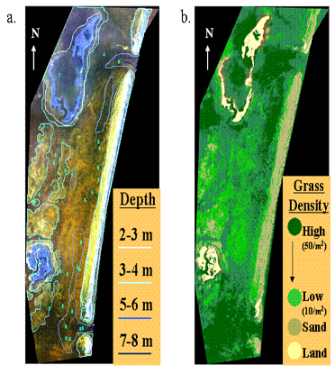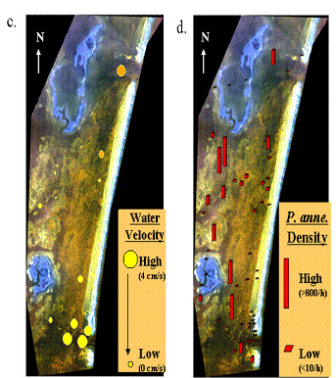Where can Photeros annecohenae be found?
Ostracods are found in almost all
aquatic environments and occupy a diverse range of niches;
however, bioluminescent ostracods (with their luminescent
courtship displays) are marine and only found in reef systems in the
Caribbean Sea (Torres and Morin 2007). (Other animals found in the Caribbean
include green
sea turtles and the common
jellyfish.) Photeros annecohenae is a grassbed species (Morin
and Cohen 2010) and serves the role of a decomposer within its
habitat.
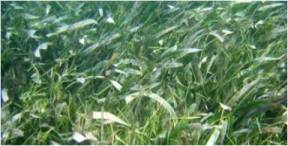 Species-specific displays act to isolate a given
species, so each particular species of bioluminescent ostracod occupies a certain
microhabitat.
Species-specific displays act to isolate a given
species, so each particular species of bioluminescent ostracod occupies a certain
microhabitat.
Photeros annecohenae is found in the Caribbean Sea off
the coast of Belize. The species can be
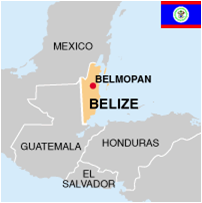 extremely abundant in this
area, with over 500 individuals found per square meter (Gerrish
2009). As
mentioned above, Photeros annecohenae occupies shallow grassbeds (usually
of Thalassia testudinalis or Syringodium filiforme (Torres
and
Morin 2007)), at
about four to five meters in depth and typically 12 to 20 meters
off the shore. This species of ostracod is primarily
benthic, and, therefore, is a “bottom-dweller.” When not
displaying, mating or
scavenging, Photeros annecohenae resides
in the sands or roots of the grassbeds at the sediment-water interphase
below where nightly-displays occur. The highest densities of
Photeros annecohenae are found in habitats that contain intermediate
densities of grass, intermediate depths of four to five
meters and in areas of no to low water velocity (See photos at
the bottom of the page). Due to their
small size, a strong current can easy sweep away Photeros
annecohenae, making food acquisition and mating difficult.
extremely abundant in this
area, with over 500 individuals found per square meter (Gerrish
2009). As
mentioned above, Photeros annecohenae occupies shallow grassbeds (usually
of Thalassia testudinalis or Syringodium filiforme (Torres
and
Morin 2007)), at
about four to five meters in depth and typically 12 to 20 meters
off the shore. This species of ostracod is primarily
benthic, and, therefore, is a “bottom-dweller.” When not
displaying, mating or
scavenging, Photeros annecohenae resides
in the sands or roots of the grassbeds at the sediment-water interphase
below where nightly-displays occur. The highest densities of
Photeros annecohenae are found in habitats that contain intermediate
densities of grass, intermediate depths of four to five
meters and in areas of no to low water velocity (See photos at
the bottom of the page). Due to their
small size, a strong current can easy sweep away Photeros
annecohenae, making food acquisition and mating difficult.
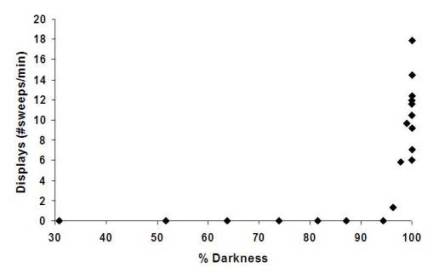 Darkness is also an extremely important part of
Photeros annecohenae’s habitat. Bioluminescent displays
by males to attract female mates must occur at times within the
"dark threshold," so, without
darkness these displays would not occur and mating of the
species would cease. This would lead to the organism's exclusion from
the given habitat. Food acquisition also occurs in times
of darkness. Obviously, darkness is a crucial resource
for Photeros annecohenae (Gerrish et al. 2009). The organism must reside in an
area where complete darkness (the dark threshold) may
be reached. Its behaviors fluctuate with differing amounts of
light and light intensity (Gerrish et al. 2009). Because of this,
the presence of artificial lighting in these habitats may lead
to severe consequences for
Photeros annecohenae and other dark-dependant organisms (Gerrish et al. 2009).
Darkness is also an extremely important part of
Photeros annecohenae’s habitat. Bioluminescent displays
by males to attract female mates must occur at times within the
"dark threshold," so, without
darkness these displays would not occur and mating of the
species would cease. This would lead to the organism's exclusion from
the given habitat. Food acquisition also occurs in times
of darkness. Obviously, darkness is a crucial resource
for Photeros annecohenae (Gerrish et al. 2009). The organism must reside in an
area where complete darkness (the dark threshold) may
be reached. Its behaviors fluctuate with differing amounts of
light and light intensity (Gerrish et al. 2009). Because of this,
the presence of artificial lighting in these habitats may lead
to severe consequences for
Photeros annecohenae and other dark-dependant organisms (Gerrish et al. 2009).
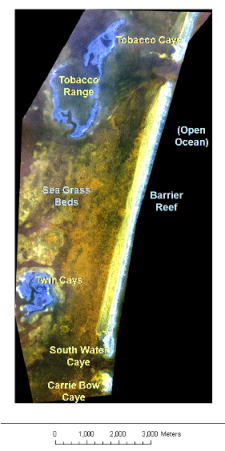
Some of the other organisms present in this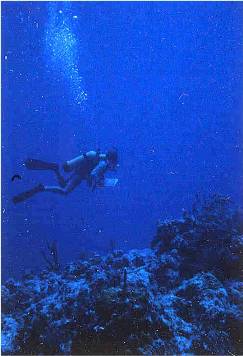 habitat include other
bioluminescent organisms, such as the
luminescent syllid polychaete worm and bioluminescent dinoflagellates, as well as sea urchins (of the genus Diadema),
manatee grass and turtle grass (in which Photeros
annecohenae resides) and the Carnidalfish, Photeros
annecohenae's most observed predator.
habitat include other
bioluminescent organisms, such as the
luminescent syllid polychaete worm and bioluminescent dinoflagellates, as well as sea urchins (of the genus Diadema),
manatee grass and turtle grass (in which Photeros
annecohenae resides) and the Carnidalfish, Photeros
annecohenae's most observed predator.
Curious to learn how Photeros annecohenae has adapted
to make life in this environment possible? View the
adaptations page.

